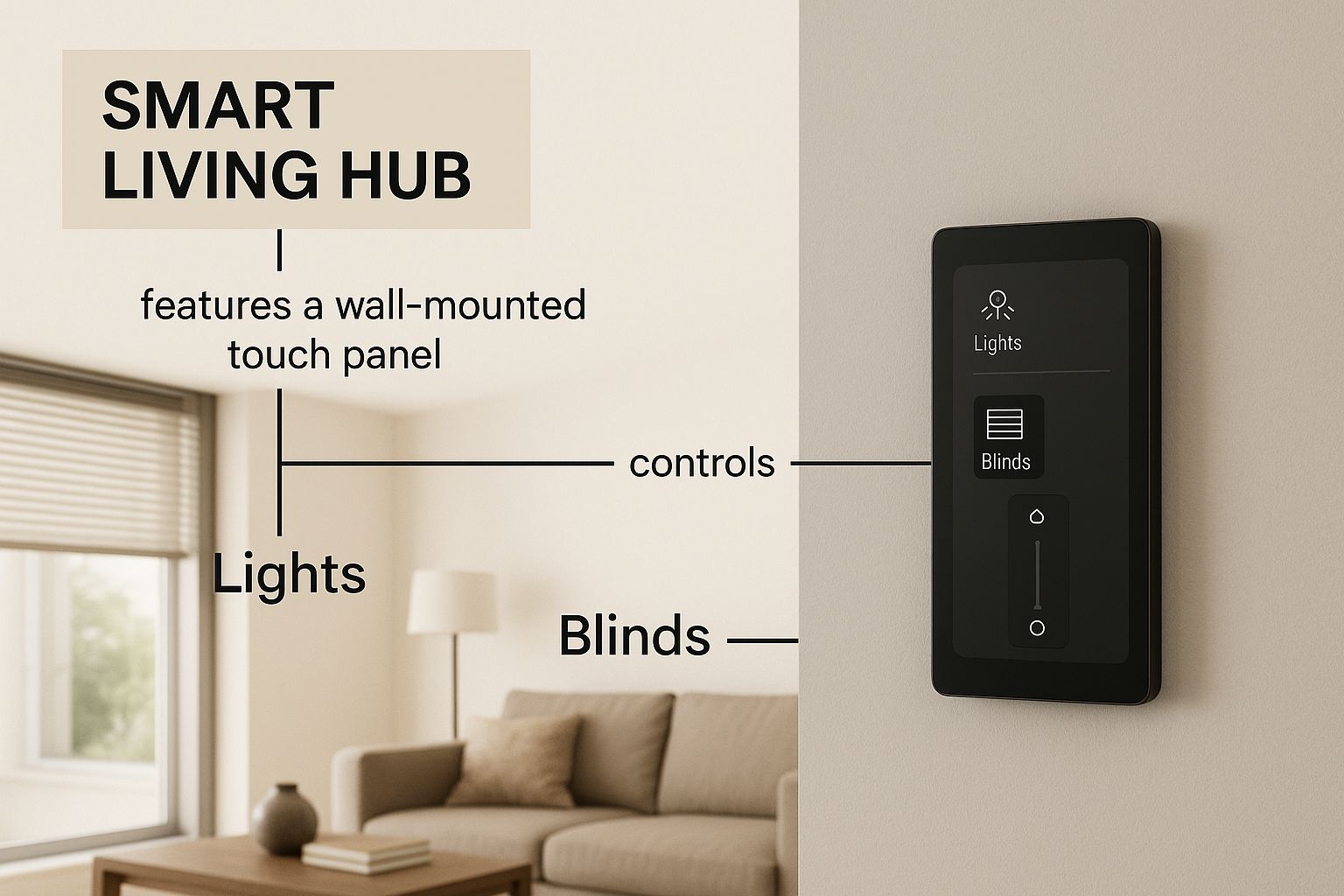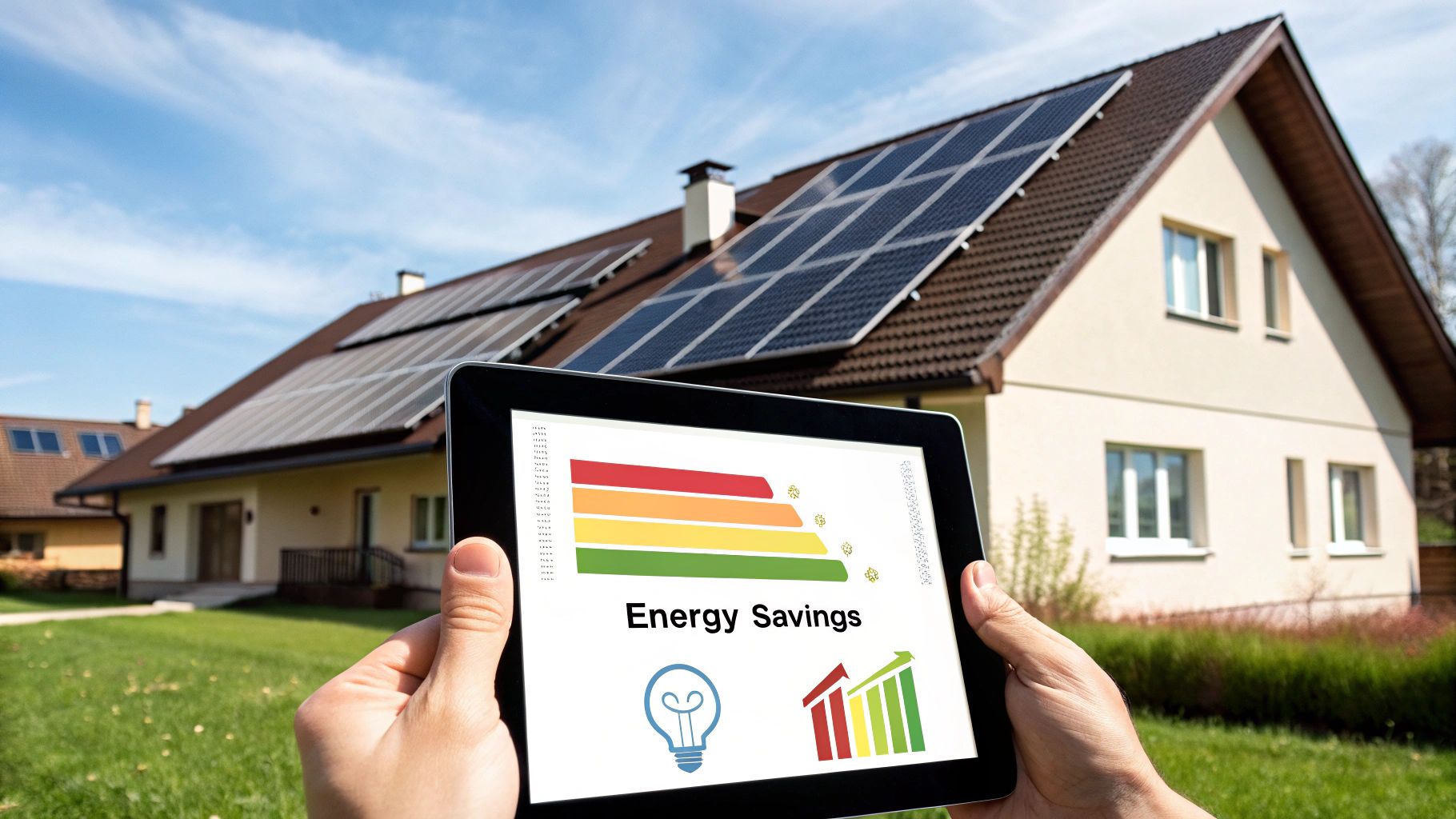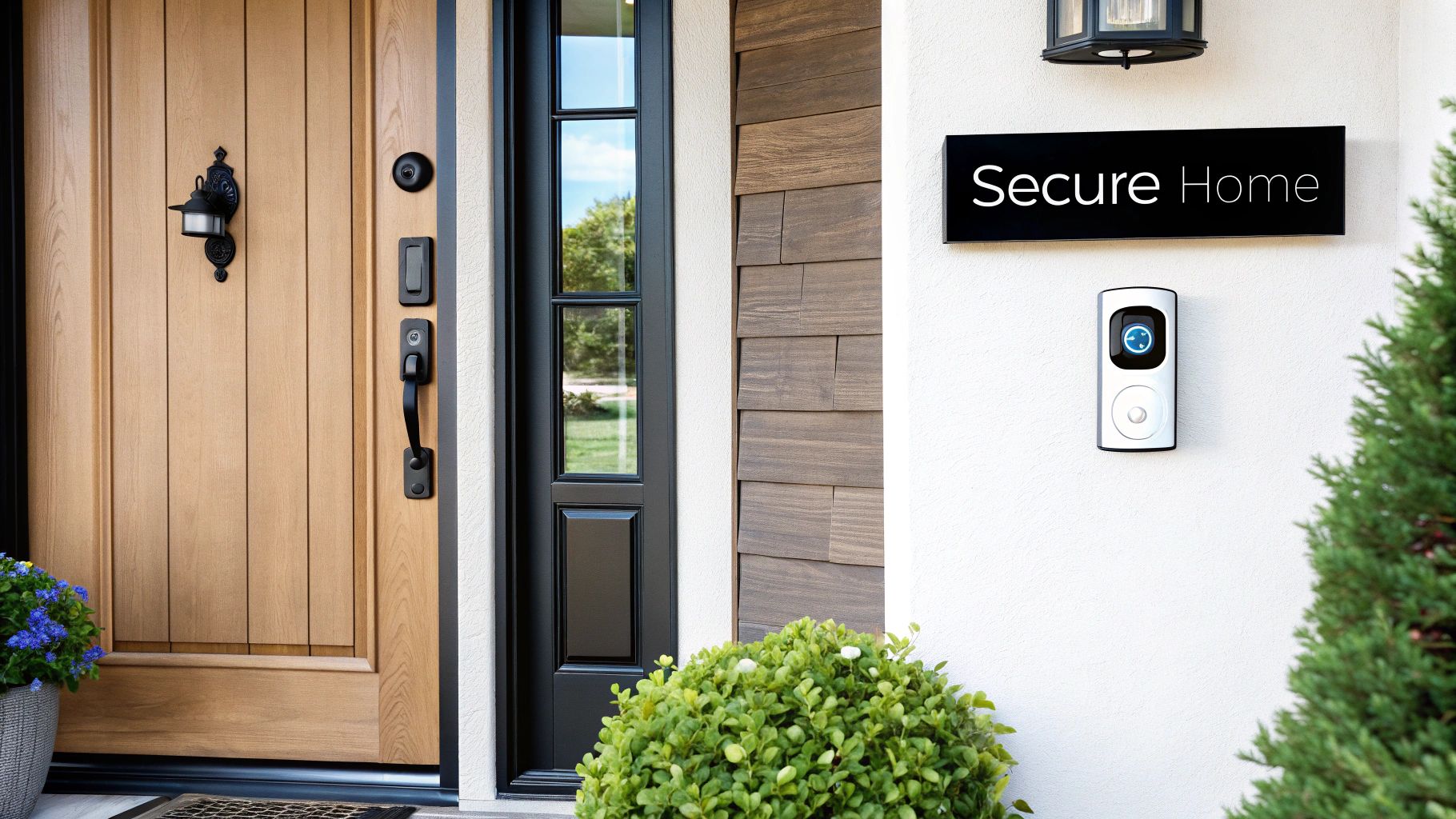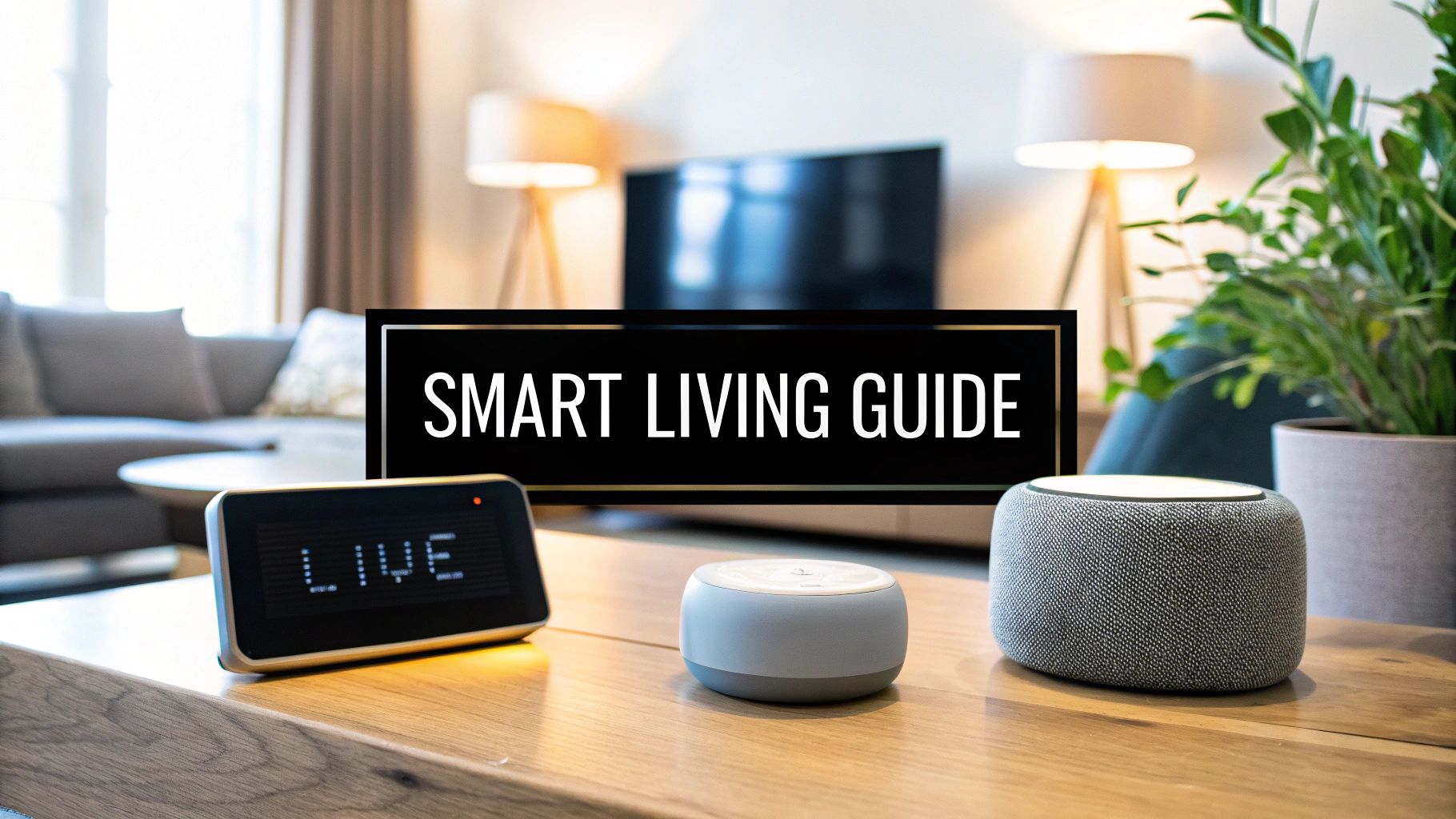We often hear the term "smart living," but what does it really mean? At its core, it’s about using connected devices to make our homes more convenient, efficient, and responsive to our daily lives.
These systems, all powered by the Internet of Things (IoT), work together to learn our routines and even anticipate what we need, turning a simple house into a truly intuitive home.
What Exactly Are Smart Living Technologies?
Think of a traditional home like an orchestra where every musician is playing their own sheet music. The thermostat, the coffee maker, the security system—they all do their job, but they don't work together. They're useful, sure, but there's no harmony.
Smart living technology is the conductor that brings all those individual instruments together. It creates a unified, seamless experience where every device communicates.
Suddenly, your alarm clock doesn't just wake you up. It also cues the coffee maker to start brewing, signals the blinds to slowly open, and nudges the thermostat to a comfortable temperature. That's the difference: it’s not just a collection of gadgets, but a single, intelligent ecosystem.
The Power of Interconnected Devices
The magic behind this coordination is the Internet of Things (IoT). In our orchestra analogy, the IoT is the invisible language that allows all the musicians to communicate with each other and the conductor. It's simply a network of everyday objects fitted with sensors and software that lets them connect and share information online.
This constant chatter between devices is what enables sophisticated automation and control from anywhere. You're not just telling your home what to do anymore; it's learning your preferences and acting on its own.
- Automation: Devices can trigger one another automatically. For instance, the moment you unlock your front door, your smart lock can tell the security system to disarm.
- Convenience: You can manage everything—from lights to locks—through a single app on your phone or with a quick voice command, whether you're at home or halfway around the world.
- Responsiveness: The home adapts to you. The lights might dim automatically when you turn on the TV for a movie, or the thermostat will lower itself when it detects you've left for the day, saving energy without you lifting a finger.
A smart home doesn’t just follow commands; it anticipates needs. It's the difference between having a tool and having a personal assistant. The real goal is an environment that works for you, so seamlessly that you barely notice it happening.
This fundamental idea—interconnected devices working together—is the bedrock of how these systems operate. They're more than just fancy gadgets; they're parts of a larger, intelligent whole designed to make life a little easier, safer, and more comfortable.
The Tech That Makes a Smart Home 'Smart'
It might seem like magic, but smart living technology is actually built on three core pillars working together. Think of it like a highly efficient team where each member has a distinct and vital job. This powerful trio—the Internet of Things, Artificial Intelligence, and seamless connectivity—is what truly brings your smart home to life.

As you can see, a central hub can become the command center for all sorts of devices, unifying everything from lighting to blinds under a single, easy-to-use control panel.
The Internet of Things: Your Home’s Nervous System
The foundation of any smart home is the Internet of Things (IoT). The best way to picture it is as your home's nervous system—a massive network of sensors and devices spread throughout every room. Just like your body's sensory organs, they're constantly gathering information and carrying out instructions.
When a motion sensor detects movement, it's like a nerve ending sending a signal. The smart bulb that flicks on in response is the muscle performing the action. This network includes everything from smart thermostats to connected coffee makers and even advanced products like motorised skylight blinds for smart home integration, which automate light and temperature control.
Each device has a simple task, but together, they create a web of awareness and responsiveness that forms the backbone of all smart living technologies. This constant flow of data is what enables more advanced automation, which brings us to the system's brain.
Artificial Intelligence: The Brain of the Operation
If IoT is the nervous system, then Artificial Intelligence (AI) is undoubtedly the brain. AI is what takes the flood of information from your IoT devices, learns from your habits, and starts making intelligent decisions for you. This is the piece that puts the "smart" in your smart home.
For example, a simple connected thermostat can be adjusted from your phone. That's convenient. But an AI-powered thermostat learns your daily schedule, figures out when you leave for work, and adjusts the temperature to save energy—all without you lifting a finger.
This decision-making capability is what turns a house that simply reacts into one that proactively cares for you. The integration of AI has been a game-changer, driving an industry valued at $127.80 billion in 2024 and projected to hit $537.27 billion by 2030. Digital assistants like Google Assistant and Amazon Alexa are perfect examples of AI making home automation feel natural and intuitive.
AI is the difference between a home that follows commands and one that understands your intent. It anticipates your needs by analyzing past behavior, turning simple data into meaningful, automated actions that simplify your life.
Of course, this level of intelligence requires a bulletproof way for the brain and the nervous system to communicate instantly. That’s where connectivity comes in.
Connectivity: The Communication Network
Finally, connectivity is the invisible network that lets all these devices talk to each other. Without it, your smart home would just be a collection of cool but isolated gadgets. This network uses a few different wireless protocols to ensure communication is fast, reliable, and consistent.
Here are the most common ones you'll encounter:
- Wi-Fi: Perfect for high-bandwidth devices that need a strong internet connection, like security cameras and smart speakers.
- Zigbee and Z-Wave: These are low-power mesh networks designed for smaller devices like sensors and smart locks. They create their own dedicated network, which helps avoid clogging up your main Wi-Fi.
- Bluetooth: Best suited for short-range communication, often used for setting up a new device or connecting accessories like a smartwatch to your phone.
You can think of these protocols as different languages spoken inside your home. A central hub or router acts as the universal translator, making sure a Zigbee motion sensor can successfully tell a Wi-Fi-connected light bulb to turn on. This seamless interplay is what makes the entire system feel like one cohesive, intelligent unit.
The Real-World Benefits of a Smarter Home

It’s one thing to understand the tech, but the real question is: why should you care? The true value of smart living technologies isn't in the gadgets themselves, but in the real, everyday improvements they bring to your life. We're moving way beyond novelty here—these are practical upgrades that boost your comfort, security, and even your bank account.
Let's break down the four core ways a smarter home makes a tangible difference, turning your daily grind into a smoother, more intuitive experience.
Enhanced Convenience and Comfort
Picture your home actually working with you. You wake up not to a jolting alarm, but to your favorite playlist gently starting as the smell of fresh coffee wafts from the kitchen. This kind of personalized comfort is what smart living is all about.
Automated routines, often called "scenes," let you set off a chain of events with a single command. A simple "Goodnight" command could lock the doors, switch off every light, and dial down the thermostat to your ideal sleeping temperature. This isn't just cool; it's about reclaiming precious time by eliminating dozens of tiny, repetitive tasks.
At its core, smart living is about creating an environment that anticipates your needs and adapts to you. It’s about smoothing out the small frictions of daily life so you can focus on what really matters.
This level of convenience touches every part of your home, making it feel both luxurious and completely effortless.
Increased Security and Safety
Peace of mind is probably the most powerful benefit of a connected home. Old-school security systems were reactive, typically only sounding the alarm after a break-in. Smart security, on the other hand, is proactive. It gives you a constant, real-time connection to your home, no matter where you are.
For instance, smart locks let you grant temporary access to a dog walker or a repair person, then automatically secure the door once they leave. Video doorbells let you see and talk to whoever is at your door from your phone, and strategically placed cameras can alert you instantly if they spot unusual motion.
Here’s what that looks like in practice:
- Real-Time Alerts: Get instant pings on your phone for things like a door opening unexpectedly or motion in the backyard.
- Remote Monitoring: Check in on your home from halfway across the world with live video feeds right on your smartphone.
- Automated Deterrents: Set your lights and speakers to turn on automatically if an intruder is detected, making it look like someone is home.
This constant vigilance provides a serious layer of protection for your family and your property. If you want to get into the weeds on how these systems can make a difference, you can explore the many other https://clouddle.com/blog/smart-home-benefits/.
Superior Energy Efficiency
A smarter home is a greener—and cheaper—home to run. A huge chunk of our utility bills comes from pure waste, like lights left on in empty rooms or heating and cooling a house when nobody's there. Smart technology tackles this inefficiency head-on, leading to some serious savings.
The smart thermostat is the classic example. It learns your daily schedule and dials back the HVAC system when you're gone, then brings the temperature back to comfortable just before you walk in the door. Likewise, smart lighting can be set to turn off when a room is empty or dim automatically based on how much daylight is coming through the windows.
These little automated tweaks really add up. A smart thermostat alone can cut heating and cooling costs by 10% to 15% each year. By trimming the fat, these systems don't just save you money; they shrink your carbon footprint, too.
Greater Accessibility and Independence
Finally, smart living has a massive impact on accessibility, empowering people with mobility challenges or disabilities to live more independently. For many, simple tasks that others take for granted can be a daily struggle.
Voice assistants like Amazon Alexa or Google Assistant are game-changers here. They allow users to control lights, thermostats, locks, and TVs just by speaking.
- Voice Control: Someone with limited mobility can turn off lights across the room without ever leaving their chair.
- Automated Routines: Doors can be programmed to unlock automatically as someone approaches, or blinds can open at the same time every morning.
- Remote Support: Family members can check in on loved ones from afar, adjust home settings for them, and get alerts if something seems off.
These features offer a renewed sense of autonomy and safety. And beyond personal comfort, adding smart tech is one of the most effective strategies to boost property value.
Smart Technology Benefits at a Glance
To quickly recap the value smart living brings, here’s a simple breakdown of the advantages we've covered.
| Benefit Category | Description | Example Devices |
|---|---|---|
| Convenience & Comfort | Automates repetitive daily tasks and personalizes the home environment to fit your lifestyle. | Smart Lighting, Smart Plugs, Robot Vacuums |
| Security & Safety | Provides proactive, 24/7 monitoring and remote control over your home’s safety features. | Video Doorbells, Smart Locks, Security Cameras |
| Energy Efficiency | Reduces energy waste by automatically adjusting lighting, heating, and cooling based on real-time needs. | Smart Thermostats, Smart Blinds, Energy Monitors |
| Accessibility & Independence | Empowers individuals with mobility challenges to control their environment with greater ease and autonomy. | Voice Assistants, Smart Speakers, Automated Doors |
As you can see, the benefits are far-reaching, transforming a house from a passive structure into an active partner in your daily life.
How to Start Building Your Smart Home

Jumping into smart living can feel like a massive undertaking, but it really doesn't have to be. The trick is to avoid trying to overhaul your entire home overnight. Instead, a more deliberate, step-by-step approach will help you build a system that genuinely makes your life easier, not more complicated.
Start Small by Solving One Problem
The best way to get started is to pinpoint a single, specific annoyance in your daily routine. Forget about creating a fully automated, futuristic house for a moment. Just focus on fixing one thing.
Tired of stumbling around in the dark looking for a light switch? Smart bulbs are your answer. Worried about porch pirates or knowing who's at the door when you're not home? A video doorbell is the perfect starting point. When you focus on solving a single, tangible problem, you get to experience the benefits of smart living technologies right away. That immediate payoff makes the whole process feel much more rewarding.
This targeted approach has some clear wins:
- Lower Initial Cost: You’re only buying one or two things, not an entire system.
- Minimal Learning Curve: You just have to get comfortable with one new app or device.
- Immediate Impact: You see the value from day one because you've solved a real problem.
Choose Your Ecosystem Wisely
Once you've gotten your feet wet, it’s time to think about the bigger picture. Your smart home devices need a "team captain" to make sure they all play well together. This is your ecosystem. Think of it like choosing between an iPhone or an Android—that decision determines which apps and accessories will work seamlessly for you.
The three main contenders in the ring are:
- Amazon Alexa: Famous for its massive compatibility with thousands of devices and its popular Echo smart speakers.
- Google Home/Assistant: Often praised for its powerful voice search and smooth integration with Google's other services.
- Apple HomeKit: Highly regarded for its strict focus on security and privacy, creating a slick experience for those already in the Apple world.
Picking an ecosystem early on is key. It saves you from the frustration of ending up with a jumble of smart gadgets that refuse to talk to each other. This decision is what allows you to create a truly connected and automated home. To get a better sense of how these devices link up, check out our guide on the Internet of Things in building automation.
Establish a Central Hub for Control
Now that you have a team captain, you need a command center. This is your central hub, the single point of control for all your smart gear. For most people, a smart speaker like an Amazon Echo or a Google Nest Mini fills this role perfectly.
A hub simplifies everything. Instead of fumbling through a half-dozen different apps, you can just use your voice to control your lights, thermostat, and locks. It’s the difference between trying to conduct an orchestra one musician at a time versus having a conductor lead a symphony.
The whole point of a smart home is to make life simpler, not to add more digital clutter. A central hub acts as a universal remote for your house, bringing all your different devices together under one easy-to-use system.
Expand Incrementally Over Time
With a solid foundation in place, you can now start adding to your system at your own pace. Because you started small and chose an ecosystem, adding new devices is surprisingly simple. Your next purchase just needs to be compatible with the platform you’ve already committed to.
This slow-and-steady approach lets your smart home grow with you. Maybe you start with lighting, then add a smart thermostat a few months later to save on energy bills. Down the road, you might install smart locks for better security. This methodical expansion is how you build a system that's not only powerful but also perfectly tailored to how you actually live.
Taking Stock of the Market and What's Next
The world of smart living isn't just growing—it's exploding. We're seeing major players like Amazon, Google, and Apple build out these incredibly powerful ecosystems, and that competition is what’s pushing the technology forward so quickly. For us, the consumers, this is great news. It means more choices and devices that actually work together as these giants fight to become the central hub of our homes.
If you look at where the action is, North America has historically been out in front. The U.S. smart home market was already valued at a staggering $36.38 billion in 2024. But where it's headed is even more impressive. Projections show it could climb to $403.09 billion by 2034, which is a compound annual growth rate of about 27.19%.
What's driving this massive wave? It really boils down to three things: people want better security, they want to save money on energy, and they want the sheer convenience that these systems offer. You can dig deeper into these growth numbers over at Precedence Research.
The Move Towards Hyper-Personalization and True Interoperability
Looking ahead, two big trends are really starting to define the future of smart living.
First up is hyper-personalization. This is where AI stops being a simple command-and-response tool and starts anticipating what you need. Think about it: instead of you telling your home what to do, it starts to understand your moods, your daily rhythms, and even your health. It could then adjust the lighting, music, and air quality to create the perfect vibe for you, often before you even consciously think about it.
The second huge shift is the push for universal interoperability, largely thanks to new standards like Matter. For years, the biggest headache was getting a device from one brand to talk to a device from another. Matter is designed to be the universal translator for these gadgets, allowing a Google Nest thermostat to communicate flawlessly with an Apple HomeKit lock. This is paving the way for a future where you can just buy the best device for the job, period, without ever worrying if it’ll fit into your setup.
The next evolution in smart living is a shift from a reactive to a proactive home. Your environment will no longer just respond to you; it will actively work to enhance your well-being, safety, and comfort without requiring constant input.
Data Privacy in a Fully Connected World
Of course, as our homes get smarter, they also collect a lot more data. This brings the conversation squarely to privacy and security. Every single smart device is a data point, and making sure that information stays protected is a massive responsibility for manufacturers and a top concern for homeowners.
Future innovation will have to be laser-focused on giving people clear, transparent control over their own data. It also means building much stronger digital fences to guard against cyber threats. The growing adoption of smart apartment technology really brings this into focus, because securing data in multi-family buildings adds a whole new layer of complexity.
Still Have Questions About Smart Living?
Thinking about dipping your toes into smart living is exciting, but it’s totally normal to have a few questions before you dive in. The tech is always changing, so let's tackle some of the most common things people wonder about.
Do I Need a Ton of Money to Start a Smart Home?
This is easily the biggest question on everyone's mind, and the answer is a pleasant surprise: absolutely not. You don’t need a massive budget to get going. The trick is to start small. Pick a single device that solves a real, everyday problem for you.
For example, a smart plug can be had for under $20 and instantly gives you phone control over any lamp or coffee maker. A single smart speaker often costs less than $50 and can act as your first command center. Forget the myth that you have to buy everything at once. The best systems are built piece by piece, as your needs and budget grow.
How Worried Should I Be About Hackers?
It's smart to think about security, but you can breathe easy—a well-managed smart home is a secure one. Reputable brands pour a ton of resources into encryption and regular security updates, so your first line of defense is simply sticking with names you know and trust. From there, a few good habits are all it takes to lock things down.
Follow these simple rules to keep your digital life safe:
- Create Strong, Unique Passwords: Don't ever reuse passwords. A password manager can do the heavy lifting for you.
- Turn On Two-Factor Authentication (2FA): This adds an essential second step to logging in, usually a code sent to your phone. It's a game-changer for security.
- Lock Down Your Wi-Fi Network: Your router is the front door to your entire smart home. Make sure it has a strong password and that you install firmware updates as soon as they're available.
Think of it like securing your actual house. You wouldn’t use the same flimsy key for your front door, back door, and garage. The same logic applies here—a little bit of digital common sense goes a long way in keeping intruders out.
Do All My Devices Have to Be From the Same Company?
This used to be a real pain. Years ago, you practically had to pledge allegiance to a single brand just to get your lights and thermostat to talk to each other. Thankfully, those days are pretty much over.
The whole industry is shifting toward universal standards. New protocols like Matter are being built to be a common language that all smart devices can speak. This means a Matter-certified smart lock will work with Apple HomeKit, Amazon Alexa, or Google Home, no fuss required. It gives you the freedom to pick the best device for the job, not just the one with the right logo.
Ready to create a smarter, more efficient, and secure environment for your business or property? The experts at Clouddle Inc specialize in designing and installing integrated technology solutions that just work. From advanced networking and Wi-Fi to comprehensive security systems, we provide the backbone for modern smart living. Discover our managed technology solutions at https://www.clouddle.com.


